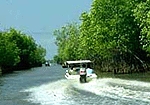|
|
|
|
Submerged forests
|
 |
|
The shape of Vietnam's southernmost area is similar to a ship headed out to sea. Over time the Mekong River has formed a unique submerged ecology that compares to that near the estuaries of the Amazon River.
Taking a boat trip from Ca Mau City (Ca Mau Province) to cajeput or mangrove forests, visitors will have a chance to see the changes in the shift of the land into a fishery-agriculture- forestry region with the cultivation of aquatic products as the core. The image of the mangroves spiking their typical roots through the mud like a net to hold onto the rich fertile soil shows that the natural accumulation is still going on at the southernmost point of Vietnam's mainland. Nature has blessed
Ca Mau with two treasures: the U Minh Ha brackish cajeput ecology in the northern part of the province and the submerged mangrove forests on both Eastern and Western coasts of the province's south. The over 500 kilometers of canals criss-crossing the 254 kilometres of the province's coasts lead to the vast fishing grounds in the Eastern Sea and the Gulf of Thailand.
For generations the life of Ca Mau locals, closely associated to the nature, is described as "easy work but good harvests "thanks to the abundance of regional natural resources from the sea and the forests. Funny stories by Ba Phi about the sharing of the habitat between the people and wild animals have been passed from mouth to mouth by locals for many years. Doan Gioi's "Southern forests" novel has won interest from readers as it was based on the real life in the province. Ca Mau also created an inviolable base for Vietnamese liberation troops fighting in the South in the 30 years of the resistance war against the U.S.
Geo-economically, besides the part of cajeput and mangrove forests that have given way to the cultivation of rice and shrimp, Ca Mau now sees 105,000 hectares of forests under good management, including 25,000 hectares of protective and specific-use forests. Priority has been given to plans of reforestation, along with goals of production and preservation of the natural environment, and as a result, the life of the locals has improved greatly. Boundless cajeput and mangrove forests criss-crossed by canals have been existing in Ca Mau for centuries. The deep silence is now and then broken by flocks of waterfowl coming back to their habitats at twilight. Friendly smiles coupled with hospitality create nice surprises to visitors who call at houses built on stilts on the merge of the water. The visit becomes unforgettable when accompanied with dried or on-the-spot grilled fish, washed down with local liquor, and friendly talk about the life in Ca Mau.
U Minh Ha forest
It is a nice experience to see brown fresh water surrounding cajeput forests in U Minh Ha that counts over 60,000 hectares of the trees in forestry companies in U Minh, Tran Van Thoi and Thoi Binh districts.
The more than 10,000 hectares of cajeput in Song Trem Forestry Company, Thoi Binh District, come under good protection as a result of the policy of contracting forests to the care of the over 1,000 households who live right in the forests allocated to them. Those locals have become experts in caring for the forests while cultivating shrimp, fish, pigs, chickens, vegetables and fruits so as to keep the harmony between the improvement of their life and the development of the forests. The Company has also marked off 110 hectares for the establishment of a cajeput eco-tourist complex where visitors will have a chance to canoe along canals to see bee hives, take a rest on hammocks hung in the shade of cajeput, smell the sweet essence of the trees, taste honey and enjoy local foods to the songs of birds and southern local folk songs. In order to preserve the natural resources and serve scientific studies, Ca Mau authorities have worked out plans and tightly protected the 400-hectare specific-use Vo Doi cajeput forests in Tran Van Thoi District, where primeval forests stand on a thick layer of peat in a valuable and rare flora and fauna. The cajeput ecological area should be protected at any cost.
Visit to Xom Mui cape
The southernmost cape, located in Xom Mui, will be connected to Ca Mau City next year with a 60-km road full of bridges of various sizes. The 120-km stretch of the water way, although endowed with beautiful scenes as it cuts through submerged forests in Tran Van Thoi, Cai Nuoc, Nam Can and Ngoc Hien Districts in the southern part of the province, makes the residence centre remote. Coming here, visitors can see mangroves and wild coconut palms emerging from the water and the busy boat activities along with the nets stretching across the canals. The southern-most district of Ngoc Hien now counts 20,000 hectares of submerged forests in 12 forestry companies that are taking great care of them.
The green mangroves lead to the last residence centre, the Xom Mui in Dat Mui, Commune, Ngoc Hien District. Locals in the area sandwiched between the Eastern Sea and the Gulf of Thailand in the middle of an ocean stream have for a long time developed a unique way to catch aquatic products: they plant poles at a suitable depth and connect them with nets across the stream to catch those creatures that follow the daily tide. Dried shrimps and fishes from Dat Mui have long been favorite products throughout the country. A complete tour of Ca Mau would include a visit to the southernmost cape, a call at Xom Mui, and a recall of the history of the land reclaiming. The nature in the forests and the sea of Ca Mau is enjoying a great attention from the Government and organizations that are making efforts in the Ca Mau Cape National Park project. |
|
|
|
|
|
